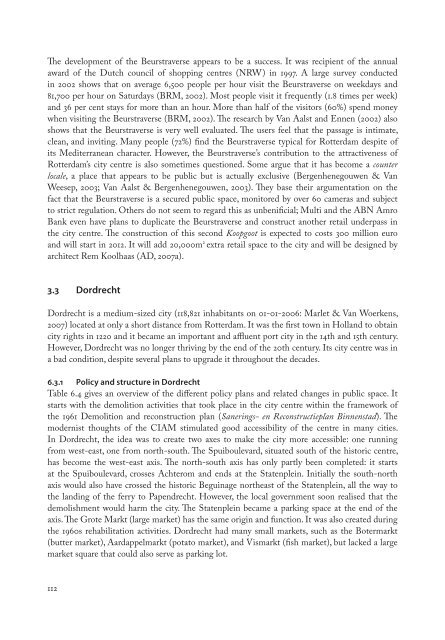Changing public space
Changing public space
Changing public space
You also want an ePaper? Increase the reach of your titles
YUMPU automatically turns print PDFs into web optimized ePapers that Google loves.
The development of the Beurstraverse appears to be a success. It was recipient of the annual<br />
award of the Dutch council of shopping centres (NRW) in 1997. A large survey conducted<br />
in 2002 shows that on average 6,500 people per hour visit the Beurstraverse on weekdays and<br />
81,700 per hour on Saturdays (BRM, 2002). Most people visit it frequently (1.8 times per week)<br />
and 36 per cent stays for more than an hour. More than half of the visitors (60%) spend money<br />
when visiting the Beurstraverse (BRM, 2002). The research by Van Aalst and Ennen (2002) also<br />
shows that the Beurstraverse is very well evaluated. The users feel that the passage is intimate,<br />
clean, and inviting. Many people (72%) find the Beurstraverse typical for Rotterdam despite of<br />
its Mediterranean character. However, the Beurstraverse’s contribution to the attractiveness of<br />
Rotterdam’s city centre is also sometimes questioned. Some argue that it has become a counter<br />
locale, a place that appears to be <strong>public</strong> but is actually exclusive (Bergenhenegouwen & Van<br />
Weesep, 2003; Van Aalst & Bergenhenegouwen, 2003). They base their argumentation on the<br />
fact that the Beurstraverse is a secured <strong>public</strong> <strong>space</strong>, monitored by over 60 cameras and subject<br />
to strict regulation. Others do not seem to regard this as unbenificial; Multi and the ABN Amro<br />
Bank even have plans to duplicate the Beurstraverse and construct another retail underpass in<br />
the city centre. The construction of this second Koopgoot is expected to costs 300 million euro<br />
and will start in 2012. It will add 20,000m 2 extra retail <strong>space</strong> to the city and will be designed by<br />
architect Rem Koolhaas (AD, 2007a).<br />
3.3 Dordrecht<br />
Dordrecht is a medium-sized city (118,821 inhabitants on 01-01-2006: Marlet & Van Woerkens,<br />
2007) located at only a short distance from Rotterdam. It was the first town in Holland to obtain<br />
city rights in 1220 and it became an important and affluent port city in the 14th and 15th century.<br />
However, Dordrecht was no longer thriving by the end of the 20th century. Its city centre was in<br />
a bad condition, despite several plans to upgrade it throughout the decades.<br />
6.3.1 Policy and structure in Dordrecht<br />
Table 6.4 gives an overview of the different policy plans and related changes in <strong>public</strong> <strong>space</strong>. It<br />
starts with the demolition activities that took place in the city centre within the framework of<br />
the 1961 Demolition and reconstruction plan (Sanerings- en Reconstructieplan Binnenstad). The<br />
modernist thoughts of the CIAM stimulated good accessibility of the centre in many cities.<br />
In Dordrecht, the idea was to create two axes to make the city more accessible: one running<br />
from west-east, one from north-south. The Spuiboulevard, situated south of the historic centre,<br />
has become the west-east axis. The north-south axis has only partly been completed: it starts<br />
at the Spuiboulevard, crosses Achterom and ends at the Statenplein. Initially the south-north<br />
axis would also have crossed the historic Beguinage northeast of the Statenplein, all the way to<br />
the landing of the ferry to Papendrecht. However, the local government soon realised that the<br />
demolishment would harm the city. The Statenplein became a parking <strong>space</strong> at the end of the<br />
axis. The Grote Markt (large market) has the same origin and function. It was also created during<br />
the 1960s rehabilitation activities. Dordrecht had many small markets, such as the Botermarkt<br />
(butter market), Aardappelmarkt (potato market), and Vismarkt (fish market), but lacked a large<br />
market square that could also serve as parking lot.<br />
112




